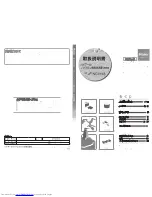
Freezing foods / storing frozen foods
Page GB-16
Freezing
Freezing means reducing the core tempera-
ture of fresh, room-temperature food to fro-
zen as quickly as possible – for best results
“flash-frozen”. If not cooled quickly enough,
the food will be “killed by frost”, i.e. the struc-
ture will be destroyed. A constant storage
temperature of -18° C is needed to maintain
the food’s consistency, taste and nutritional
value.
Preparing the food
• Only freeze high quality food.
• Freeze fresh and prepared food dry and
unseasoned. Unsalted foods are more
durable.
• Allow prepared food to cool before freez-
ing. This not only saves power, but also
prevents excessive frost formation in the
freezer area.
• Carbonated drinks are not suitable for
freezing because the carbon dioxide es-
capes during freezing.
Suitable packaging
Packaging is important when freezing. This
will protect against oxidation, penetration by
microbes, transfer of odours and flavourings
and drying out (freezer burn).
• Only use packaging material that is
strong, impermeable to air and liquid, not
too stiff and labelled. It should be desig-
nated as suitable for freezer use.
Portions
• Create flat portions if possible; these
freeze through to the core faster.
• Expel the air from the freezer bag as this
causes the contents to dry out and takes
up space.
• Use plastic clips, rubber bands or adhe-
sive tapes to seal.
• Fill liquid containers no more ¾ full, be-
cause liquids expand when frozen.
• Do not store glass or metal containers of
liquid. The containers can burst.
• Only freeze high-proof alcohol that is
tightly sealed.
• Label the frozen food by type, quantity,
freezing and expiry date. Use waterproof
marker pens or adhesive labels wherever
possible.
How to pack the freezer properly
Maximum freezing capacity
Adhere to the maximum freezing capacity.
You will find information about ‘Freezing ca-
pacity in kg/24 hours’ in the product fiche on
page GB-33.
Freeze smaller quantities
• up to 2 kg: Once the freezer temperature
is -18° C, you can freeze fresh, room-tem-
perature foods.
• over 2 kg: Keep fresh goods out of con-
tact with existing frozen foods as they
could start to thaw. If contact with stored
food cannot be avoided, we recommend
that you create a cold reserve in the
freezer compartment before freezing the
fresh goods, thus further lowering the
temperature in the freezer compartment.
The temperature in the freezer briefly rises af-
ter placing fresh goods inside. After 24 hours,
the goods are frozen to the core.
















































